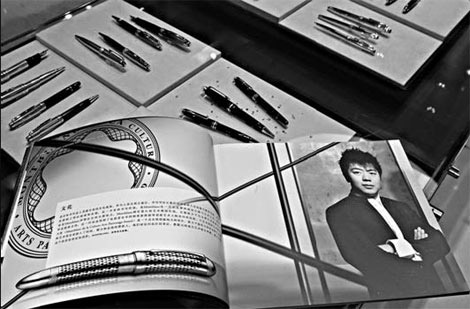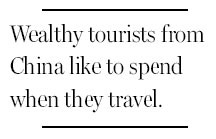Top retailers court Chinese customers
 |
|
Many high-end stores have started marketing to traveling Chinese shoppers. Montblanc features the pianist Lang Lang in a brochure. Andrea Mohin / The New York Times |

Over five days in January, a group of visitors to New York was treated to a private concert with the pianist Lang Lang at the Montblanc store, cocktails and a fashion show attended by the designers Oscar de la Renta and Diane Von Furstenberg, and a tour of Estee Lauder's original office.
They were not celebrities. They were not government officials. They were Chinese tourists with a lot of money.
Though luxury brands started opening stores in Beijing and Shanghai years ago, Chinese shoppers still spend more on luxury products abroad than they do at home, according to the consulting firm Frost & Sullivan. Because of China's taxes, luxury products are about a third cheaper elsewhere.
European luxury stores have been catering to Chinese tourists for years. Now high-end retailers in the United States are pulling out their Mandarin phrase books and trying to convince Chinese visitors that Americans can do luxury, too.
"What started as a trickle has now become a flow," said Ben Macklowe, the vice president of the antiques store Macklowe Gallery. "There's been prosperity across so much of Asia that you're starting to see it much more in the profile of the tourist on Madison Avenue."
A record number of Chinese visited the United States last year - nearly 1.1 million, according to the Commerce Department. The number of visitors is expected to almost double by 2014, according to the U.S. Travel Association. Chinese visitors spend about $6,000 each on every visit here, versus the $4,000 that visitors from other countries spend on average, the association says.
Luxury purchases are surging in part because American stores carry a broader range of products than their counterparts in China, said Julia Zhu, consulting director for Frost & Sullivan.
Tiffany, which made almost a quarter of its United States revenue last year from foreign tourists, has added Mandarin-speaking sales people to its major stores, as has Burberry, where more than half of sales at its flagship stores are to tourists.
Despite having more than 100 stores in China, Montblanc is going after Chinese shoppers on vacation abroad. "Yes, we are in the major cities, but when you travel, you're in the mood to enjoy and experience the moment," said Jan-Patrick Schmitz, chief executive of Montblanc North America. "We certainly will do more and more marketing toward them."
Retailers in the United States have to overcome an idea that luxury cannot come from the United States.
"The European brands, they see prestige, history, heritage," said Sunny Wong, group managing director of Trinity, a company that owns and operates high-end European retail brands in China. American brands, by contrast, are seen as "contemporary, lifestyle" rather than pure luxury, he said.
Mr. Macklowe recently met with Chinese tour operators.
"You have to tailor your message for the crowd, and for this crowd it was, 'These are very exclusive things, these are very authentic things, these are very high-end things that you can recommend to your clients without reservation,'" he said. "We tried to give them a sense that what we do only exists in one place on earth."














